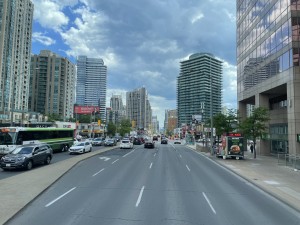Cars are inefficient and destructive. We can no longer afford to give them so much public space
Toronto’s motor champions still operate under the delusion cars are crucial to urban mobility, instead of mainly getting in the way of better options.
City policies to reduce greenhouse gas emissions, improve equity and increase road safety would all benefit from fewer cars. But community groups that fight for an extra sliver of the road — for wider sidewalks, bike lanes and busways — face a number of hurdles, beginning with an apparent obligation to justify their demands against potential adverse impacts on motorists.
The conversion of a road lane to other purposes usually provokes howls of indignation from motoring enthusiasts. For instance, consider when Toronto finally installed a bike lane last year on midtown Yonge Street, between Bloor and Davisville Avenue. Some motorists from adjacent, tony neighbourhoods demanded its immediate removal. The opponents actually described themselves as “landlocked,” despite having two motor (plus turning) lanes on Yonge, the pilot bike lane, pleasant sidewalks, a TTC subway line, and the city’s best amenities within walking distance.
The best way for motorists to expand, or at least to preserve, their disproportionate share of the road usually involves little more than driving more. The traffic jam, easily created, is itself a scream for attention, dutifully answered by city hall. The purchase of a bigger vehicle, including absurdly sized SUVs and pickups, is a good way to expand one’s own share of the public road.
Council’s motor champions still operate under the delusion that cars are crucial to urban mobility, instead of mainly getting in the way of better options. When the Bloor bike lane was extended in 2020, these councillors argued that it would prevent west-enders from going downtown. The city’s own numbers told a different story: among 267,000 people travelling through the corridor, there were fewer than 23,000 cars — most with single occupants. The great majority of people took the subway.
Long ago, the anxiety provoked by the question, “Where will I park?” created the political pressure to disfigure cities to store idle cars. In today’s city, for each car there are at least four — and perhaps as many as eight — parking spots, many at the curbside of our roads. Ironically, while the city cheerfully hands out (underpriced) parking spots on residential and arterial roads, it protects, with vigilant parsimony, any intrusion on public space by the homeless.
